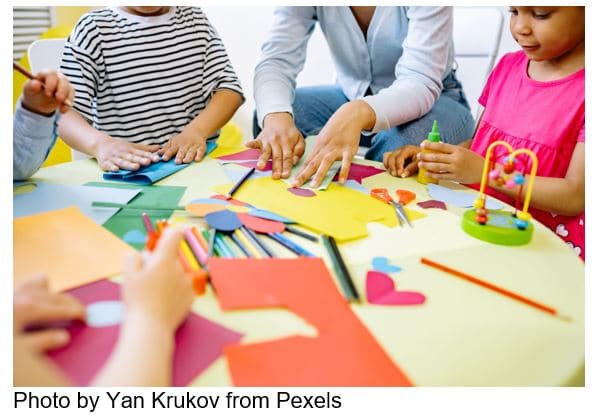
Plus, 4 Best Practices to Consider When Applying
Written by: Christy S. Renjilian
You know that the economy has taken a hit in the last year and a half. How could it not? With shutdowns, stock market fluctuations, supply chain implications.
But did you know there is a crisis in the childcare industry?
The funding model isn’t stainable, and it’s at a breaking point.
The impact on children, families, educators, and businesses is huge.
For educators, the business model is built on low wages. Families can’t afford the true cost of care, and most can’t even afford the tuition that is currently being charged.
And costs are lowered by paying workers lower rates. The average salary for a child care teacher is $10.79.
$10.79. Yes, you read that right. For all their talent and compassion, as well as their advanced degrees, that is the average pay rate. Hard to believe, right?
These educators are responsible for young children’s well-being, for their learning, social development, language, and motor skills; they lead their classrooms as well as playtime, safety measures, and emotional support. And they are masters, masters at organizing art projects, preparing snack time and mealtime, potty training, field trip outings, and cleaning and sanitizing throughout each day. Add to that positive parent interaction and peer and management communication. And reliability. That’s at the top of the list.
Let’s agree that they have a big job.
And the wage problem hurts every part of the business model.
Educators are no longer willing to accept that pay rate. And can you blame them? It’s not a sustainable wage, and they need more to better support their own families.
Businesses are struggling to recruit, hire, and retain workers.
Families face both economic and educational challenges. People can’t work if they don’t have child care. They also know that the quality of the care the children receive greatly impacts their child’s ability to be successful in school and life. They want to pay for high-quality care because they know it’s important, but they also know the cost can be high.
And for our children, our youth, this crisis could influence their long-term success. It is the early years, the ones before kindergarten, that are the most critical period of brain development.
“The highest rate of return in early childhood development comes from investing as early as possible, from birth through age five, in disadvantaged families. Skills beget skills in a complementary and dynamic way. Efforts should focus on the first years for the greatest efficiency and effectiveness.”
—James J. Heckman
How ARPA Stabilization Grants can help make quality child care more affordable
The American Rescue Plan Act, passed by President Biden earlier this year, included federal grant money for each state to administer to assist early childhood education. These Stabilization Grants are to help programs with expenses related to COVID including personal protective equipment, cleaning, health & safety practices, personnel costs, rent/mortgage, facilities maintenance, equipment and supplies, and mental health support for employees, children, and families.
To be eligible to apply, providers must be Department of Human Services (DHS) Certified, as of 3/11/2021, and be open, or have submitted a plan to OCDEL to reopen. The provider must be operating on a regular or provisional DHS Certificate of Compliance.
To apply, visit www.pakeys.org.
The money is being invested in this way in order to keep the child care industry in business. To support their efforts to respond to the COVID pandemic, the staffing crisis, and increased costs.
The providers have flexibility, within set guidelines, to spend the money in a way to address their critical needs. Funds will be paid out over a period of six months.
So, if you’re eligible and would like to apply, Community Connections for Children, Inc. encourages you to do so. Here are a few things to consider.
Four best practices to consider when applying for ARPA funds.
When considering this grant opportunity, approach it as you do anything in your business, thoughtfully and strategically. And think about the long game, how you might spend the funds so that you can sustain the investment once ARPA funds have run out.
Think through the question, How can I utilize ARPA funds to cover existing expenses in a way that will further stretch and save my other revenue sources? Other revenue sources could include Child Care Works, along with parent fees and tuition.
It’s important for both center and home-based programs to list out their needs and their wants; and once you know the amount you will receive through the ARPA grant, begin to prioritize needs. If there is money left over, then consider the wants.
To help you craft a plan, consider these best practices:
- For a center provider, allocating a significant portion of your ARPA funds to personnel costs may be a wise investment. Personnel costs are the largest portion of a program’s budget. Funds can be used for salary increases, stipends, benefits, tuition reimbursement, etc.
- If there are building issues that have always been put on the “back burner”, now might be the time to address them. Particularly if they relate to the safety of the children and staff, such as improvements to the HVAC system, air purifiers, etc.
- For home-based providers, who often don’t pay themselves much at all, now is the time to invest in yourself as a small business owner and professional educator. Funds can be used to enhance your benefits package and business acumen with things like tuition assistance.
- Funds can also be utilized to make improvements to your home to better serve the children and families who receive care there.
For more information, visit www.pakeys.org to better understand and comply with the grant.
What is Community Connections for Children role in the distribution of funds?
CCC is responsible for assisting providers in utilizing the online portal to apply for ARPA grants. Our STARS Quality Coaches are able to assist providers. In addition to CCC’s guidance, keep in mind that PA Keys has support available too.
CCC also reviews and approves the applications for the seven counties we serve in ERLC 9 and 10, including Dauphin, Cumberland, Perry, Lebanon, York, Adams, and Lancaster. In ERLC 8, CCC assists with the approval process.
To date, approximately 55% of providers have submitted their applications and been approved. CCC has paid out over $14.5 million
Please note, CCC will be issuing payments every other week as providers submit their applications and are approved. Approved providers will receive six payments (one each month starting with their first payment), and CCC will manage and implement this payment cycle.
What does success look like for the grant program?
The pandemic has had a profound impact on the childcare industry, with the added stress and pressures of working with children and parents. The tensions over masks, quarantining, vaccines, etc. have greatly impacted the morale of the workforce. An industry that never stopped working. Because as we have seen, if parents don’t have child care, they can’t work either. When schools shut down, most child care programs remained open.
If more centers close due to the staffing crisis, if more children are on waiting lists as a result of these closures, more and more people will be forced to leave the workforce.
A successful Stabilization Grant program would help child care programs remain open.
With a large number of child care programs operating at reduced enrollment due solely to the staffing crisis, it’s my hope that ARPA funds are used to help increase salaries and provide benefits to assist with hiring and retention.
For true, long-term success, my hope is that ARPA funding leads to systemic changes in how we structure the child care industry and how much public and private funding is available to families to help them pay for child care.
As a region, we’re cautiously optimistic. More and more people are understanding that the economic systems of our communities rest on the backs of the child care industry.
And they are taking steps to better support their child care centers. But we have more work to do for sustainable change.
Continued Reading
CCC: A Little Love for Early Childhood Education Workers
Heckman: Invest in Early Childhood Development: Reduce Deficits Strengthen the Economy
About Community Connections for Children, Inc.
Community Connections for Children, Inc. (CCC) is a nonprofit centered in the heart of Pennsylvania. They serve childcare providers and low-income families ‒ the ones that have been impacted the most by the pandemic.
For you and your business, CCC helps keep childcare options open for your employees ‒ saving missed work hours and lowering on-the-job stress levels. They work with early childhood education programs and home-based providers to improve the quality of care, ensuring that all children enter school ready to be successful.
CCC works with many local businesses’ HR departments to help their employees find childcare. They also encourage businesses to support the child care industry through the Educational Improvement Tax Credit, direct financial support, partnering with local Early Childhood Educators to contract for slots or expand their programs, and providing scholarships/ tuition assistance as part of their benefits package.
Christy Renjilian serves as its Executive Director.
To learn more, visit childcareconsultants.org.

